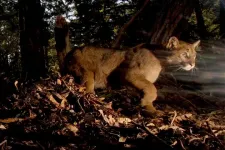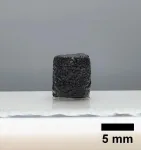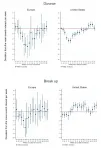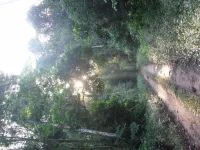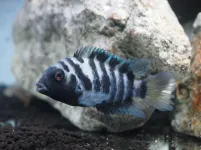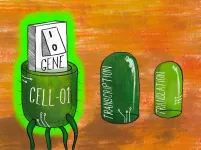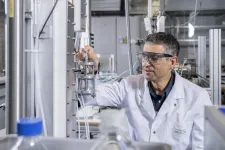(Press-News.org) CHAMPAIGN, Ill. -- A camera-trap study in the Mendocino National Forest in Northern California reveals that black bears are adept at finding and stealing the remains of adult deer killed by pumas. This "kleptoparasitism" by bears, as scientists call it, reduces the calories pumas consume in seasons when the bears are most active. Perhaps in response to this shortage, the pumas hunt more often and eat more small game when the bears are not in hibernation.
The findings are published in the journal Basic and Applied Ecology.
Pumas, also known as mountain lions or cougars, are apex predators, but this doesn't mean they can't be threatened by other carnivores, said study lead author Max Allen, a research scientist at the Illinois Natural History Survey who studies big cats and other carnivorous mammals.
"Bears are dominant scavengers, and their large body size means that they can take carcasses from apex predators," Allen said. He and his colleagues became interested in this phenomenon when they saw signs of bear scat and bear claw marks near puma kills.
The researchers used GPS collars to track seven pumas across a 386-square-mile territory over a period of two years. Whenever a puma made a kill, it would repeatedly visit or spend a lot of time at that location. The researchers visited those sites to document the type of animals the puma had killed and to look for signs of bears. They also set up camera traps at many of the kill sites to determine which animals were eating the remains.
The team documented 352 puma kills, of which 64 were animals other than deer. The smaller prey animals included dozens of squirrels, birds and rabbits, but also a coyote, two gray foxes, a fisher and two black bears. The pumas also went after fawns, which they can eat quickly, likely before a bear discovers them, Allen said.
The bears discovered kills of adult deer within about two days, cutting the pumas' feeding time at a deer carcass from 5-7 days in winter to about two days when the bears showed up.
The study found the highest frequency of puma kills ever reported. And the kill rate increased when bears were most active.
"There were only about 0.68 mountain lions per 100 square kilometers in our study area," Allen said. "An average number would be two to three. The average home range for a female in Santa Cruz is between 30 and 35 square kilometers. But in Mendocino it was over 200."
Despite the large territory available to them, pumas were not getting the full benefit of their kills. The amount they consumed varied month to month, from more than 190 pounds of meat in January, when bears were least active, to less than 110 pounds in April. Bear scavenging of adult deer carcasses was highest in the warmer months, but the researchers found evidence of bears at puma kills every month of the year.
"We found evidence to suggest that the bears are having an impact on pumas and how often they're killing deer," Allen said. "When a bear pushes a puma off of a carcass, the puma runs away, and the bear eats the deer. The puma then has to make another kill in order to get the energy it needs."
In the absence of black bears, pumas made a kill about once a week, Allen said.
"But in the presence of bears, they're killing every five to six days," he said. "They have to work harder, and they're getting less nutrition overall."
INFORMATION:
The INHS is a division of the Prairie Research Institute at the University of Illinois Urbana-Champaign.
The California Department of Fish and Wildlife; University of California, Davis; and California Deer Association supported this project.
Editor's notes:
To reach Max Allen, email: maxallen@illinois.edu
The paper "Can't bear the competition: Energetic losses from kleptoparasitism by a dominant scavenger may alter foraging behaviors of an apex predator" is available online and from the U. of I. News Bureau.
Due to their tissue-like mechanical properties, hydrogels are being increasingly used for biomedical applications; a well-known example are soft contact lenses. These gel-like polymers consist of 90 percent water, are elastic and particularly biocompatible. Hydrogels that are also electrically conductive allow additional fields of application, for example in the transmission of electrical signals in the body or as sensors. An interdisciplinary research team of the Research Training Group (RTG) 2154 "Materials for Brain" at Kiel University (CAU) has now developed a method to produce hydrogels with an excellent level of electrical conductivity. What makes this method special is that the mechanical properties of ...
Google Trends reveal how searches related to family and relationship behaviors, such as weddings, contraception, and abortions, changed during lockdowns in the US and Europe.
INFORMATION:
Link to publicly available article: https://journals.plos.org/plosone/article?id=10.1371/journal.pone.0248072
Funding: The authors received no specific funding for this work.
Competing Interests: The authors have declared that no competing interests exist.
Article URL: https://journals.plos.org/plosone/article?id=10.1371/journal.pone.0248072
...
How did life begin on Earth and could it exist elsewhere? Researchers at Simon Fraser University have isolated a genetic clue--an enzyme known as an RNA polymerase--that provides new insights about the origins of life. The research is published today in the journal Science.
Researchers in SFU molecular biology and biochemistry professor Peter Unrau's laboratory are working to advance the RNA World Hypothesis in answer to fundamental questions on life's beginnings.
The hypothesis suggests that life on our planet began with self-replicating ribonucleic acid (RNA) molecules, capable of not only carrying genetic information but also driving chemical reactions essential for life, prior to the evolution ...
In the future, droughts could be even more severe than those that struck parts of Germany in 2018. An analysis of climate data from the last millennium shows that several factors have to coincide to produce a megadrought: not only rising temperatures, but also the amount of solar radiation, as well as certain meteorological and ocean-circulation conditions in the North Atlantic, like those expected to arise in the future. A group of researchers led by the Alfred Wegener Institute have just released their findings in the journal Communications Earth & Environment.
Despite the precipitation this winter, which in ...
Large areas of forests regrowing in the Amazon to help reduce carbon dioxide in the atmosphere, are being limited by climate and human activity.
The forests, which naturally regrow on land previously deforested for agriculture and now abandoned, are developing at different speeds. Researchers at the University of Bristol have found a link between slower tree-growth and land previously scorched by fire.
The findings were published today [date] in Nature Communications, and suggest a need for a better protection of these forests if they are to help mitigate the effects of climate change.
Global forests are expected to contribute a quarter of pledged mitigation under the ...
OSAKA, Japan. If you were given the option to eat a delicious meal by yourself, or share that meal with your loved ones, you would need as very good excuse ready if you chose the former. Turns out, fish share a similar inclination to look after each other.
For the first time ever, a research group led by researcher Shun Satoh and Masanori Kohda, professor of the Graduate School of Science, Osaka City University, have shown these altruistic tendencies in fish through a series of prosocial choice tasks (PCT) where they gave male convict cichlid fish two choices: the antisocial option of receiving food for themselves alone and the prosocial option of receiving food for themselves and their partner.
"As a result, it can be said that the convict cichlid ...
In a recent study led by the University of Bristol, scientists have shown how to simultaneously harness multiple forms of regulation in living cells to strictly control gene expression and open new avenues for improved biotechnologies.
Engineered microbes are increasingly being used to enable the sustainable and clean production of chemicals, medicines and much more. To make this possible, bioengineers must control when specific sets of genes are turned on and off to allow for careful regulation of the biochemical processes involved.
Their findings are reported today in the journal Nature Communications.
Veronica Greco, lead author ...
Scientists have discovered in more detail than ever before how the human body's immune system reacts to malaria and sickle cell disease.
The researchers from the universities of Aberdeen, Edinburgh, Exeter and Imperial College, London have published their findings in Nature Communications.
Every year there are ~200 million cases of malaria, which causes ~400,000 deaths.
As it causes resistance against malaria, the sickle cell disease mutation has spread widely, especially in people from Africa.
But if a child inherits a double dose of the gene - from both mother and father - they will develop ...
Researchers at the Paul Scherrer Institute PSI have for the first time observed photochemical processes inside the smallest particles in the air. In doing so, they discovered that additional oxygen radicals that can be harmful to human health are formed in these aerosols under everyday conditions. They report on their results today in the journal Nature Communications.
It is well known that airborne particulate matter can pose a danger to human health. The particles, with a maximum diameter of ten micrometres, can penetrate deep into lung tissue and settle ...
Sabrina L. Spencer, PhD, is a CU Boulder researcher and a CU Cancer Center member. Spencer recently won two awards: the Damon Runyon-Rachleff Innovation Award (from the Damon Runyon Cancer Research Foundation) and the Emerging Leader Award (from The Mark Foundation for Cancer Research). The preliminary research she used to apply for the grants, "Melanoma subpopulations that rapidly escape MAPK pathway inhibition incur DNA damage and rely on stress signalling," was published in Nature Communications on March 19, 2021. We spoke to Spencer about the awards and how she plans to use them to ...
